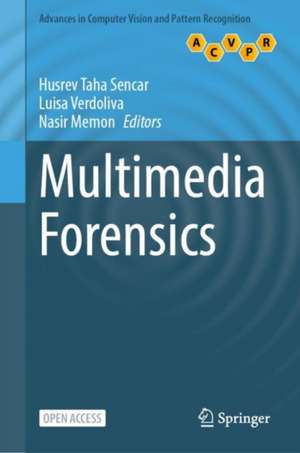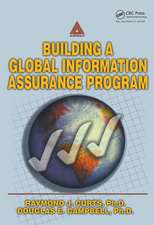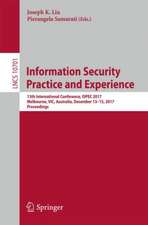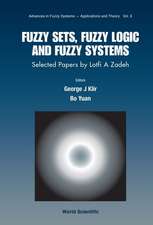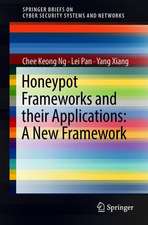Multimedia Forensics: Advances in Computer Vision and Pattern Recognition
Editat de Husrev Taha Sencar, Luisa Verdoliva, Nasir Memonen Limba Engleză Paperback – 2 apr 2022
In this new threat landscape powered by innovative imaging technologies and sophisticated tools, based on autoencoders and generative adversarial networks, this book fills an important gap. It presents a comprehensive review of state-of-the-art forensics capabilities that relate to media attribution, integrity and authenticity verification, and counter forensics. Its content is developed to provide practitioners, researchers, photo and video enthusiasts, and students a holistic view of the field.
| Toate formatele și edițiile | Preț | Express |
|---|---|---|
| Paperback (1) | 314.18 lei 6-8 săpt. | |
| Springer Nature Singapore – 2 apr 2022 | 314.18 lei 6-8 săpt. | |
| Hardback (1) | 377.50 lei 6-8 săpt. | |
| Springer Nature Singapore – 2 apr 2022 | 377.50 lei 6-8 săpt. |
Din seria Advances in Computer Vision and Pattern Recognition
- 20%
 Preț: 998.36 lei
Preț: 998.36 lei - 20%
 Preț: 409.80 lei
Preț: 409.80 lei - 20%
 Preț: 654.70 lei
Preț: 654.70 lei - 20%
 Preț: 775.30 lei
Preț: 775.30 lei - 20%
 Preț: 867.15 lei
Preț: 867.15 lei - 20%
 Preț: 241.87 lei
Preț: 241.87 lei - 20%
 Preț: 659.83 lei
Preț: 659.83 lei - 20%
 Preț: 1084.17 lei
Preț: 1084.17 lei - 20%
 Preț: 328.60 lei
Preț: 328.60 lei - 20%
 Preț: 650.08 lei
Preț: 650.08 lei - 20%
 Preț: 644.66 lei
Preț: 644.66 lei - 20%
 Preț: 652.54 lei
Preț: 652.54 lei - 20%
 Preț: 646.80 lei
Preț: 646.80 lei - 20%
 Preț: 993.60 lei
Preț: 993.60 lei - 20%
 Preț: 1174.92 lei
Preț: 1174.92 lei - 20%
 Preț: 646.80 lei
Preț: 646.80 lei - 20%
 Preț: 672.36 lei
Preț: 672.36 lei - 20%
 Preț: 1166.52 lei
Preț: 1166.52 lei - 20%
 Preț: 920.33 lei
Preț: 920.33 lei - 20%
 Preț: 825.78 lei
Preț: 825.78 lei - 20%
 Preț: 666.58 lei
Preț: 666.58 lei - 18%
 Preț: 953.65 lei
Preț: 953.65 lei - 20%
 Preț: 999.35 lei
Preț: 999.35 lei - 20%
 Preț: 655.02 lei
Preț: 655.02 lei - 20%
 Preț: 595.16 lei
Preț: 595.16 lei - 20%
 Preț: 647.61 lei
Preț: 647.61 lei - 20%
 Preț: 658.33 lei
Preț: 658.33 lei - 20%
 Preț: 1649.61 lei
Preț: 1649.61 lei - 20%
 Preț: 991.46 lei
Preț: 991.46 lei - 20%
 Preț: 994.08 lei
Preț: 994.08 lei - 20%
 Preț: 1062.57 lei
Preț: 1062.57 lei - 20%
 Preț: 985.16 lei
Preț: 985.16 lei - 20%
 Preț: 640.35 lei
Preț: 640.35 lei - 20%
 Preț: 656.03 lei
Preț: 656.03 lei - 18%
 Preț: 950.52 lei
Preț: 950.52 lei - 20%
 Preț: 652.41 lei
Preț: 652.41 lei - 20%
 Preț: 644.81 lei
Preț: 644.81 lei - 20%
 Preț: 996.40 lei
Preț: 996.40 lei
Preț: 314.18 lei
Preț vechi: 392.73 lei
-20% Nou
Puncte Express: 471
Preț estimativ în valută:
60.13€ • 62.54$ • 49.64£
60.13€ • 62.54$ • 49.64£
Carte tipărită la comandă
Livrare economică 14-28 aprilie
Preluare comenzi: 021 569.72.76
Specificații
ISBN-13: 9789811676239
ISBN-10: 9811676232
Pagini: 515
Ilustrații: XII, 490 p. 151 illus., 137 illus. in color.
Dimensiuni: 155 x 235 x 29 mm
Greutate: 0.7 kg
Ediția:1st ed. 2022
Editura: Springer Nature Singapore
Colecția Springer
Seria Advances in Computer Vision and Pattern Recognition
Locul publicării:Singapore, Singapore
ISBN-10: 9811676232
Pagini: 515
Ilustrații: XII, 490 p. 151 illus., 137 illus. in color.
Dimensiuni: 155 x 235 x 29 mm
Greutate: 0.7 kg
Ediția:1st ed. 2022
Editura: Springer Nature Singapore
Colecția Springer
Seria Advances in Computer Vision and Pattern Recognition
Locul publicării:Singapore, Singapore
Cuprins
What's In This Book and Why?.- Media Forensics in the Age of Disinformation.- Computational Imaging.- Sensor Fingerprints: Camera Identification and Beyond.- Source Camera Attribution from Videos.- Source Camera Model Identification.- GAN Fingerprints in Face Image Synthesis.- Physical Integrity.
Notă biografică
Husrev Taha Sencar is a principal scientist with the cyber-security group of the Qatar Computing Research Institute, HBKU, and an associate professor at Computer Eng. Department of TOBB University, Ankara, Turkey. Between 2012 and 2015, he served as the director of the New York University Abu Dhabi’s Center for Cyber-Security in UAE. He published more than 90 articles on topics related to digital forensics, information hiding, and biometrics. He was the technical program chair for the 2016 IEEE Workshop on Information Forensics and Security. He served in the PC of several conferences with a focus on digital forensics, such as WIFS, IS&T MWSF, ICME, EUSIPCO. He also served on the editorial board of IEEE Transactions on Information Forensics and Security and continues to serve on the board of IEEE Transactions on Image Processing. His research has primarily focused on building and implementing advanced forensic capabilities that relate to extraction, search and organization, attribution, and authentication of digital evidence.
Dr. Luisa Verdoliva is an associate professor at University Federico II of Naples, Italy, where she leads the Multimedia Forensics Lab. Her scientific interests are in the field of image and video processing, with main contributions in the area of multimedia forensics. She has published over 120 academic publications, including 45 journal papers. She has actively contributed to the academic community through service as general co-chair of the 2019 ACM Workshop on Information Hiding and Multimedia Security, technical chair of the 2019 IEEE Workshop in Information Forensics and Security, and area chair of the IEEE International Conference on Image Processing since 2017. She is on the editorial board of IEEE Transactions on Information Forensics and Security and IEEE Signal Processing Letters. Dr. Verdoliva is a chair of the IEEE Information Forensics and Security Technical Committee. She is the recipient of the 2018 Google Faculty Award for Machine Perception and a TUM-IAS Hans Fischer Senior Fellowship (2020-2023). She has been elected to the grade of IEEE Fellow, effective January 1, 2021.Nasir Memon is a vice-dean for Academics and Student Affairs and a professor of Computer Science and Engineering at the New York University Tandon School of Engineering. He is an affiliate faculty at the Computer Science department in NYU's Courant Institute of Mathematical Sciences and department head of NYU Tandon Online. He introduced cyber-security studies to NYU Tandon in 1999, making it one of the first schools to implement the program at the undergraduate level. He is a co-founder of NYU's Center for Cyber-Security (CCS) at New York as well as NYU Abu Dhabi. He is the founder of the OSIRIS Lab, CSAW, the Bridge to Tandon Program as well as the Cyber-Fellows program at NYU. He has received several best paper awards and awards for excellence in teaching. He has been on the editorial boards of several journals, and wasthe editor-in-chief of the IEEE Transactions on Information Security and Forensics. He is an IEEE Fellow and an SPIE Fellow for his contributions to image compression and media security and forensics. His research interests include digital forensics, biometrics, data compression, network security and security and human behavior.
Dr. Luisa Verdoliva is an associate professor at University Federico II of Naples, Italy, where she leads the Multimedia Forensics Lab. Her scientific interests are in the field of image and video processing, with main contributions in the area of multimedia forensics. She has published over 120 academic publications, including 45 journal papers. She has actively contributed to the academic community through service as general co-chair of the 2019 ACM Workshop on Information Hiding and Multimedia Security, technical chair of the 2019 IEEE Workshop in Information Forensics and Security, and area chair of the IEEE International Conference on Image Processing since 2017. She is on the editorial board of IEEE Transactions on Information Forensics and Security and IEEE Signal Processing Letters. Dr. Verdoliva is a chair of the IEEE Information Forensics and Security Technical Committee. She is the recipient of the 2018 Google Faculty Award for Machine Perception and a TUM-IAS Hans Fischer Senior Fellowship (2020-2023). She has been elected to the grade of IEEE Fellow, effective January 1, 2021.Nasir Memon is a vice-dean for Academics and Student Affairs and a professor of Computer Science and Engineering at the New York University Tandon School of Engineering. He is an affiliate faculty at the Computer Science department in NYU's Courant Institute of Mathematical Sciences and department head of NYU Tandon Online. He introduced cyber-security studies to NYU Tandon in 1999, making it one of the first schools to implement the program at the undergraduate level. He is a co-founder of NYU's Center for Cyber-Security (CCS) at New York as well as NYU Abu Dhabi. He is the founder of the OSIRIS Lab, CSAW, the Bridge to Tandon Program as well as the Cyber-Fellows program at NYU. He has received several best paper awards and awards for excellence in teaching. He has been on the editorial boards of several journals, and wasthe editor-in-chief of the IEEE Transactions on Information Security and Forensics. He is an IEEE Fellow and an SPIE Fellow for his contributions to image compression and media security and forensics. His research interests include digital forensics, biometrics, data compression, network security and security and human behavior.
Textul de pe ultima copertă
This book is an open access. Media forensics has never been more relevant to societal life. Not only media content represents an ever-increasing share of the data traveling on the net and the preferred communications means for most users, it has also become integral part of most innovative applications in the digital information ecosystem that serves various sectors of society, from the entertainment, to journalism, to politics. Undoubtedly, the advances in deep learning and computational imaging contributed significantly to this outcome. The underlying technologies that drive this trend, however, also pose a profound challenge in establishing trust in what we see, hear, and read, and make media content the preferred target of malicious attacks.
In this new threat landscape powered by innovative imaging technologies and sophisticated tools, based on autoencoders and generative adversarial networks, this book fills an important gap. It presents a comprehensive review of state-of-the-art forensics capabilities that relate to media attribution, integrity and authenticity verification, and counter forensics. Its content is developed to provide practitioners, researchers, photo and video enthusiasts, and students a holistic view of the field.
In this new threat landscape powered by innovative imaging technologies and sophisticated tools, based on autoencoders and generative adversarial networks, this book fills an important gap. It presents a comprehensive review of state-of-the-art forensics capabilities that relate to media attribution, integrity and authenticity verification, and counter forensics. Its content is developed to provide practitioners, researchers, photo and video enthusiasts, and students a holistic view of the field.
Caracteristici
This book is open access, which means that you have free and unlimited access Offers a comprehensive and authoritative introduction to digital forensics of multimedia data and devices Each chapter is authored by researchers active in the field Provides points to various code and data sources to help readers to practice and implement the methods easily
